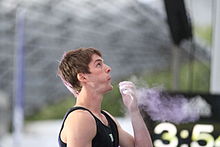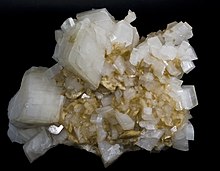Magnesium carbonate
| Structural formula | ||||||||||||||||||||||
|---|---|---|---|---|---|---|---|---|---|---|---|---|---|---|---|---|---|---|---|---|---|---|

|
||||||||||||||||||||||
| General | ||||||||||||||||||||||
| Surname | Magnesium carbonate | |||||||||||||||||||||
| other names | ||||||||||||||||||||||
| Molecular formula | MgCO 3 | |||||||||||||||||||||
| Brief description |
colorless solid |
|||||||||||||||||||||
| External identifiers / databases | ||||||||||||||||||||||
|
||||||||||||||||||||||
| Drug information | ||||||||||||||||||||||
| ATC code | ||||||||||||||||||||||
| properties | ||||||||||||||||||||||
| Molar mass | 84.31 g · mol -1 | |||||||||||||||||||||
| Physical state |
firmly |
|||||||||||||||||||||
| density |
2.96 g cm −3 (20 ° C) |
|||||||||||||||||||||
| Melting point |
> 350 ° C (decomposition) |
|||||||||||||||||||||
| solubility |
very sparingly soluble in water (0.106 g l −1 at 20 ° C) |
|||||||||||||||||||||
| safety instructions | ||||||||||||||||||||||
|
||||||||||||||||||||||
| MAK |
Switzerland: 3 mg m −3 (measured as respirable dust ) |
|||||||||||||||||||||
| Thermodynamic properties | ||||||||||||||||||||||
| ΔH f 0 |
−1095.8 kJ / mol |
|||||||||||||||||||||
| As far as possible and customary, SI units are used. Unless otherwise noted, the data given apply to standard conditions . | ||||||||||||||||||||||
Magnesium carbonate , MgCO 3 is an inorganic chemical compound .
Occurrence
Magnesium carbonate occurs naturally in large quantities as magnesite (bitter spar) (MgCO 3 ) with a hardness of 4–4½. Along with dolomite, it is the most important magnesium mineral. Also known is the minerals are Barringtonit MgCO 3 · 2 H 2 O, nesquehonite (MgCO 3 · 3 H 2 O) and Lansfordit MgCO 3 · 5 H 2 O.
Extraction and presentation
Magnesium carbonate precipitates from magnesium salt solutions with alkali metal carbonates, but only if there is an excess of carbon dioxide. Otherwise, basic carbonates such as "Magnesia alba" are formed.
Amorphous anhydrous magnesium carbonate, so-called upscalite , could only recently be produced by a low-temperature synthesis and has a high specific surface area of 800 m² / g MgCO 3 . Until then, only syntheses at elevated temperature were known, which is known in the literature as the “magnesite problem”.
properties
The neutral magnesium carbonate , which contains water of crystallization , changes into basic magnesium carbonate , especially when heated :
Magnesium carbonate, together with calcium carbonate (lime), is mainly responsible for the development of water hardness . It crystallizes trigonal , space group R 3 c (space group no. 167) , with the lattice parameters a = 4.637 Å and c = 15.02 Å.
use
Magnesium carbonate comes on the market as 4 MgCO 3 · Mg (OH) 2 · 4–5 H 2 O containing water of crystallization as Magnesia alba , light magnesia (CAS number 12125-28-9). An aqueous suspension of 50 g / l of water has a basic reaction and a pH of about 10.5.
Food
Magnesium carbonate is a component of mineral and medicinal waters.
Adsorber
Because of the large specific surface area of 800 m² / g, Upsalit (water-free nano- magnesium carbonate) is suitable as an adsorber for dehumidifiers and the binding of oil on water. A use as a carrier material for pharmaceutical substances, in which the controllability of the pore size is exploited, is also being researched.
Food additive
In the food industry, magnesium carbonate is added to foods as an acidity regulator , carrier or release agent. It is considered harmless to health, but large amounts can have a laxative effect.
In the EU , it is approved as an additive with the number E 504 without maximum quantity restrictions for all foods that may contain additives. This also includes organic products .
Insulating and filling material
It is used in thermal insulation materials and as a filler in plastics, paper, paints and rubber, and in cosmetics in powders.
drug
Together with calcium carbonate , magnesium carbonate is used in drugs for gastric acid regulation ( antacids ).
Sports
Magnesium carbonate is sold by the producers under the names Magnesium Carbonate, Magnesia or Chalk. The product is used by gymnasts , strength athletes and climbers to dry the hand perspiration and thus to increase the grip of the hands and the ability to slide on the device bars. It is available in pressed block form, as a loose powder and recently also as a liquid suspended in alcohol.
Sport climbing

In sport climbing , it was first used by John Gill for the bouldering used, who brought the idea from the gymnastics.
The magnesia is carried in lockable, portable bags, so-called chalk bags . They are attached to the climbing harness at the back, at coccyx height. As soon as the climber gets wet hands while climbing, he can reach into the opened bag. As a rule, magnesia is also used preventively so that the hands cannot get wet in the first place. The chalk bag is usually filled directly with powder or blocks ground into powder. As an alternative, you can also carry a chalk ball in the bag. These are thin and permeable fabric balls filled with magnesia, which have the advantage of lower consumption and reduced dust production. Since dust can be a problem in climbing gyms, there are some hall regulations that only allow chalkballs and prohibit open magnesia.
In some climbing areas, such as in Saxon Switzerland, the use of magnesia is not permitted or at least undesirable for various reasons:
- The residues of magnesium carbonate remaining in the grips “pull” water from the environment ( hygroscopy ), which makes grips permanently moist / slippery and thus makes climbing without magnesia difficult.
- The "drawn" water collects in certain types of rock (e.g. sandstone), when it is frosty it gains volume and can thus destroy the stone surface.
- It leads to the optical impairment of the rock surface (white spots on the rocks). There is also colored magnesia for this use.
- It causes a long-term change in the physical and chemical properties of the rock (reduction of friction, chemical conversion of the minerals). Critics object that this only applies to the sandstone and that it is mainly based on assumptions.
- Nature conservation: Magnesia acts like a basic fertilizer in larger quantities, but effects on the soil, flora and fauna of rocks have not yet been scientifically proven.
- Reduction of the sporting requirements: The marking of the grips on the rock, which is achieved either knowingly or as a side effect of the use of magnesia, makes it easier to find them, thus reducing the sporting challenge.
Apparatus gymnastics and weight training
In gymnastics and weight training, the magnesia is placed in containers near the place of performance. The athletes then dry their palms in it before starting the exercise so that their skin does not adhere too tightly when gripping the bars of parallel bars or the iron bars of horizontal bars or barbells .
Refractory products
Refractory materials are made from magnesite primarily in the steel and iron industry (steel ladles or electric furnaces), but also in the cement or glass industry (lining rotary kilns or glass melting furnaces). The magnesite transforms on heating with evolution of carbon dioxide in magnesium oxide to. The world's largest and most important manufacturer is RHI AG , which emerged from the Veitsch-Radex Group. The magnesite deposits are distributed worldwide. In Austria, magnesite is currently being mined and processed directly in the Breitenau and Hochfilzen .
Magnesite is an additive or the sole raw material for technical ceramics, for refractory crucibles and sticks . Here, the magnesite is transformed into magnesium oxide ceramic during firing or it is fired beforehand and used as magnesium oxide in powder form.
Individual evidence
- ↑ Entry on E 504: Magnesium carbonates in the European database for food additives, accessed on June 27, 2020.
- ↑ Entry on MAGNESIUM CARBONATE in the CosIng database of the EU Commission, accessed on July 2, 2020.
- ↑ Hans-Dieter Jakubke, Ruth Karcher (Ed.): Lexicon of Chemistry , Spectrum Academic Publishing House, Heidelberg, 2001.
- ↑ a b c d e Entry on magnesium carbonate in the GESTIS substance database of the IFA , accessed on December 21, 2019 (JavaScript required)
- ↑ Swiss Accident Insurance Fund (Suva): Limit values - current MAK and BAT values (search for 546-93-0 or magnesium carbonate ), accessed on November 2, 2015.
- ↑ David R. Lide (Ed.): CRC Handbook of Chemistry and Physics . 90th edition. (Internet version: 2010), CRC Press / Taylor and Francis, Boca Raton, FL, Standard Thermodynamic Properties of Chemical Substances, pp. 5-20.
- ↑ Erwin Riedel, Christoph Janiak: Inorganic Chemistry . Walter de Gruyter, 2011, ISBN 3-11-022567-0 , p. 607 ( limited preview in Google Book search).
- ↑ Johan Forsgren, Sara Frykstrand, Kathryn Grandfield, Albert Mihranyan, Maria Strømme: "A template-free, ultra-adsorbing, High Surface Area Carbonate Nano Structure"; In: PLOS one, doi : 10.1371 / journal.pone.0068486
- ↑ JC Deelman (2011): Low-temperature formation of dolomite and magnesite, Chapter 6 - Magnesite & huntite (PDF; 229 kB).
- ↑ KD Oh, H. Morikawa, SIIwai, H. Aoki: The crystal structure of magnesite. In: American Mineralogist , 58, 1973, pp. 1029-1033.
- ↑ Forsgren, J .; Frykstrand, S .; Grandfield, K .; Mihranyan, A. & Strømme, M .: A Template-Free, Ultra-Adsorbing, High Surface Area Carbonate Nanostructure . PLoS ONE , Public Library of Science, 2013, 8, p. E68486. doi : 10.1371 / journal.pone.0068486
- ↑ Spiegel Online: Impossible Material from Uppsala: Upsalit accidentally made , August 14, 2013.
- ↑ Uppsalamaterial promising for drug NyTeknik, August 10, 2016 Retrieved on October 7, 2016 (Swedish).
- ↑ Climbing in the Elbe Sandstone Mountains ( Memento from September 5, 2011 in the Internet Archive )
- ^ Juliane Friedrich: Mountain sports and nature conservation in Saxon Switzerland - effects, conflicts, possible solutions . tape 2 . Diploma thesis Technical University of Dresden, Dresden 2002, p. 47 f . ( ssi-heft.de [PDF; accessed on March 29, 2008]).
- ↑ Pöller, U. (2013): Influence of climbing on the pH value and electrical conductivity of the soil in the wall foot area. Bachelor thesis at the University of Bayreuth.
- ↑ Fichert, T. (2014): On the influence of climbing on silicate rock ecosystems, University of Passau.
- ↑ Aschauer, H. (1985): Study on magnesia powder. Munich



